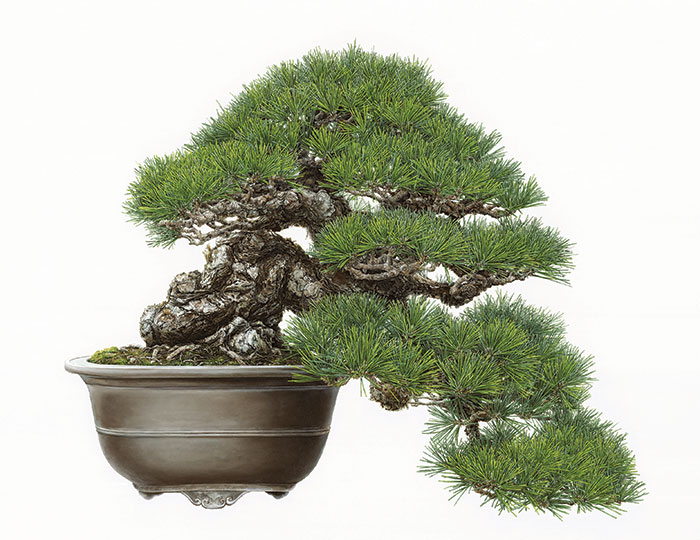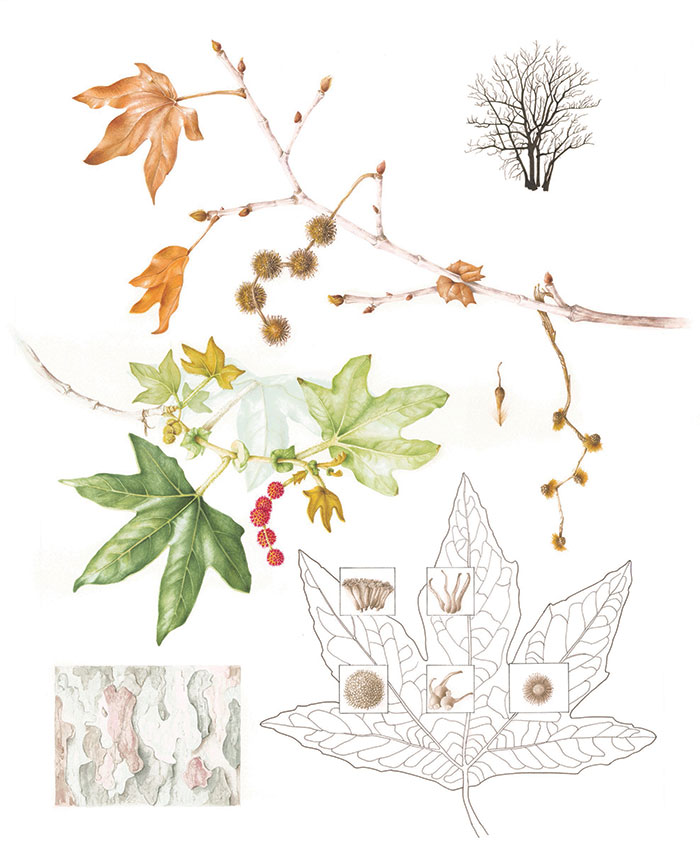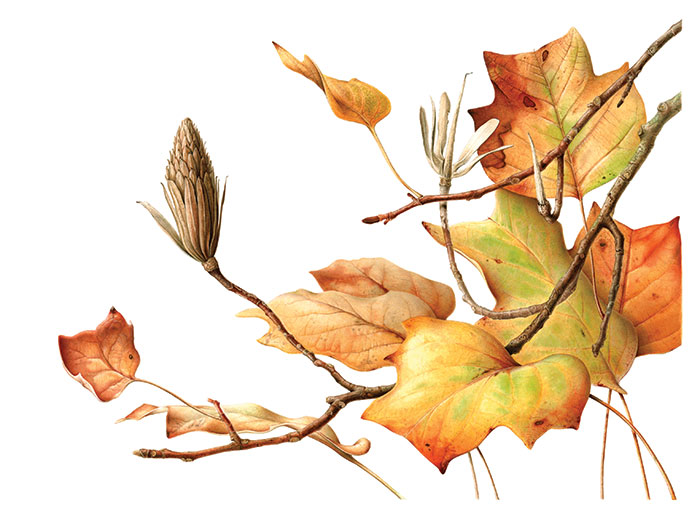The Huntington’s blog takes you behind the scenes for a scholarly view of the collections.
Out of the Woods
Posted on Wed., May 16, 2018 by

Asuka Hishiki, Black Pine Half-Cascade-Style Bonsai (2015-2017), Pinus nigra, Omiya Bonsai Art Museum, Saitama, Japan. Oil on paper, 28 ¼ x 36 ½ inches. © Asuka Hishiki. Courtesy of the American Society of Botanical Artists and the New York Botanical Garden.
Visitors to public gardens tend to view trees as background. Exotic blooms, shimmering ponds, and sweeping vistas of color draw the eye more readily. “Out of the Woods: Celebrating Trees in Public Gardens”—an exhibition of botanical illustrations opening May 19 in the Flora-Legium gallery located in The Huntington’s Brody Botanical Center—focuses on trees in all their glorious detail.
The subjects of the 43 illustrations, selected from more than 200 submissions, were cultivated in public gardens located on five continents. And one of the trees is at The Huntington.
“Like everything else in the garden, trees are part of our collections and objects of study,” notes Robert Hori, The Huntington’s Gardens Cultural Curator and Program Director.

Deborah Friedman, California Sycamore (2016), Platanus racemosa, The Huntington Library, Art Collections, and Botanical Gardens, San Marino, California. Watercolor and ink on paper, 24 x 19 inches. © Deborah Friedman. Courtesy of the American Society of Botanical Artists and the New York Botanical Garden.
Trees clean the air, moderate temperatures, provide habitat and food for animals, absorb storm water, and help prevent erosion. Threats to this vital resource—invasive pests, development, deforestation, climate change—led the New York Botanical Garden and the American Society of Botanical Artists to focus on trees for this third in a series of triennial exhibitions to tour the country.
Beyond environmental considerations, trees resonate with us on a spiritual level—as many “Out of the Woods” artists attest.
As a child riding her bicycle through a canyon, Deborah Friedman recalls watching red-tailed hawks soar above their nests in massive sycamore treetops. This cherished memory is one reason she chose to depict the California Sycamore—based on multiple specimens, including one located by the terrace of The Huntington’s Café 1919—for her entry in the juried show.
The ‘Fibonacci spirals’ of the Screw-Pine’s unusual fruits fascinated Margaret Best on her first view of them. She finalized her selection from the Bermuda Arboretum in Devonshire, Bermuda, when one of the fully ripe fruits, part of a mantelpiece decoration in a home where she was staying, exploded, disseminating its seeds and emitting a tropical aroma.

Margaret Best, Screw-Pine (2017), Pandanus utilis, Bermuda Arboretum, Devonshire, Bermuda. Watercolor on paper, 18 ½ x 14 ¼ inches. © Margaret Best. Courtesy of the American Society of Botanical Artists and the New York Botanical Garden.
Asuka Hishiki’s oil painting of a Black Pine Half-cascade Style Bonsai from the Omiya Bonsai Art Museum in Saitama, Japan, won the juried show’s Gold Medal. The pine’s aging dignity left her awestruck. “The thick layered trunk is bold and strong, and it tells you the long but calm life the tree has had.”
Botanical illustration demands scientific as well as artistic skills. Friedman rendered the California Sycamore not only for “Out of the Woods,” but also for a project toward her diploma from the Royal Botanic Garden Edinburgh Distance Learning Course.
Following exacting standards, she studied the tree in all seasons, rendered a full silhouette, bark and leaf details, branching architecture, and flower and fruit development. She made flower dissections, pressed and preserved plant parts, kept a sketchbook, and took hundreds of photographs to record her observations. (You can watch a video of Friedman discussing her process on YouTube.)
Two more entries represent Southern California as well: Mitsuko Schultz’ Sweet Gum from the Los Angeles County Arboretum and Botanic Garden, and Olga Ryabtsova’s Roxburgh Fig from the San Diego Botanic Garden.

Esmée Winkel, Leiden's 300-Year-Old Tulip Tree in Autumn (2016), Liriodendron tulipifera. Hortus Botanicus Leiden, Leiden, The Netherlands. Watercolor on paper. © Esmée Winkel. Courtesy of the American Society of Botanical Artists and the New York Botanical Garden.
Our region is but one stop on the exhibition’s global journey. Arresting images abound, from the orchid-like flowers of the Noz-moscada Africana in the Jardim Botânico, Rio de Janeiro, Brazil; to the slim cones of the 300-year-old Tulip Tree of Hortus Botanicus Leiden, The Netherlands; to the intricate tangle of roots and fibers of the Invasive Chinese Banyan Tree of Kowloon Park, Hong Kong, China. The artworks of “Out of the Woods”—in watercolor, ink, oil, color pencil, and graphite—trace the cycle of life.
An adjunct exhibition, “Amazing Trees,” featuring works by the Botanical Artists’ Guild of Southern California (BAGSC)—a chapter of the American Society of Botanical Artists—will be on view adjacent to “Out of the Woods.”
Drop-in family activities centered around botanical art and facilitated by BAGSC will be offered in the Brody Botanical Center every Saturday and Sunday from noon to 4 p.m. through the run of the exhibition, May 19–Aug. 27, 2018.
Linda Chiavaroli is a volunteer in the office of communications and marketing at The Huntington.